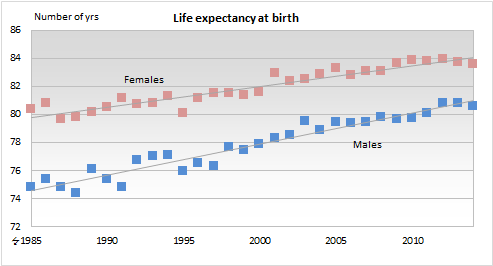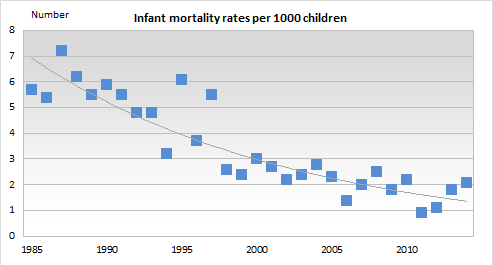In 2014, the life expectancy in Iceland was 80.6 years for men and 83.6 years for women.
Life expectancy at birth measures how long, on average, people can be expected to live at a given moment in time based on the population age-specific mortality rates. These rates have been decreasing over the last decades. As a result, we can expect people to live longer than the calculated life expectancy shows.
This is also reflected in the long time evolution of the life expectancy, which has increased by six and four years for men and women respectively, during the last 30 years (see figure below).

Ten years averages (2004-2013) show that men in Iceland and Switzerland share the first place in Europe, with a 79.1 years long life expectancy. They are followed by Sweden and Liechtenstein (78.5 years), by Italy (78.3) and Norway (77.9 years). The shortest life expectancies belong to men in Estonia (68.8), Latvia (66.4) and Lithuania (66.1).
According to the same ten years averages, women in France and Spain have the longest life expectancy in Europe (84.1 years). The next highest values belong to Switzerland (83.8), Italy and Liechtenstein (83.6) and Iceland (82.7 years). The lowest values are recorded in Bulgaria (76.8), the Former Yugoslav Republic of Macedonia (76.3) and Serbia (76.1 years).
Infant mortality in Iceland – the lowest in Europe
In 2014, 2,049 individuals died in Iceland, 1,059 men and 999 women. The mortality rate was 6.3 per 1,000 inhabitants and the infant mortality rate was 2.1 per 1,000 life births.

The infant mortality rate in Iceland averaged over a ten years period (2004-2013) was 1.9 per 1,000 life births and is the lowest rate in Europe. The second lowest average values (2.6) are recorded in Sweden and Finland as well as in Norway, Slovenia, Luxembourg and Czech Republic (2.9). The highest infant mortality rates are recorded in Turkey (11.6).
Notes
The ten years average values for life expectancy and mortality rates are based on Eurostat database.